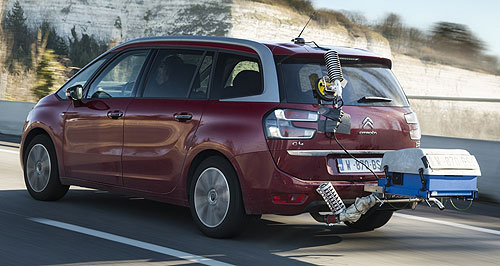PSA first to publish real-world fuel figures
BY HAITHAM RAZAGUI | 4th Mar 2016

During this week’s Geneva motor show, PSA revealed real-world results for three of its most popular models – which were on average 44 per cent higher than official figures based on the New European Driving Cycle – and announced plans to release figures for a total of 30 vehicles by mid-year.
In conjunction with non-governmental organisations (NGOs) Transport & Environment and France Nature Environment, PSA developed a test protocol based on EU RDE measurement methods and encompassing real-life driving conditions such as passenger and luggage loads and air-conditioning use.
A public road circuit near Paris was used, comprising 25.5 kilometres of urban, 39.7km of extra-urban and 31.1km of motorway driving, while independent auditor Bureau Veritas was engaged to ensure testing was conducted in line with protocol specifications and that the results were accurate.
By comparing the results with vehicle owners’ fuel usage measurements obtained through independent customer surveys, PSA confirmed the accuracy of these tests.
Testing on a Peugeot 308 Allure 1.6-litre diesel with idle-stop and six-speed manual transmission resulted in 5.0 litres per 100 kilometres, while the customer survey average was between 5.0L/100km and 5.1L/100km.
A Citroen C4 Grand Picasso Exclusive with the same drivetrain achieved 5.6L/100km under the protocol compared with between 5.5 and 5.7L/100km in customer data.
The biggest variance was a DS3 So Chic with the same drivetrain as the other two vehicles, which recorded 4.9L/100km in testing while customers recorded between 5.1 and 5.3L/100km.
PSA says the initial results show the protocol developed is “scientifically robust and representative of a typical driver”.
GoAuto compared these results with lab-based NEDC combined cycle data, which rates the 308 variant tested at just 3.2L/100km, the C4 Grand Picasso at 4.0L/100km and the DS3 at 3.6L/100km.
It translates to the real-world thirst of models tested being respectively 56 per cent, 40 per cent and 36 per cent higher than official – but seemingly misleading – NEDC figures.
As Volkswagen Group and a number of other carmakers face scrutiny over the emissions of vehicles they produce in the wake of the ‘dieselgate’ scandal, the decision by PSA to make public its real-world test results serves to give its brands a sheen of transparency.
Bureau Veritas executive vice president of marketing, sales and communication Marc Boissonnet described PSA’s collaboration with NGOs and an independent certification organisation in developing an conducting the tests as “both innovative and constructive”.
“It meets all the conditions for addressing issues that may be raised by consumers. PSA Peugeot Citroen has done what was necessary to ensure an independent and credible verification that can set the standard for the automotive industry,” he said.
